window RENAULT CLIO 2009 X85 / 3.G Owners Manual
[x] Cancel search | Manufacturer: RENAULT, Model Year: 2009, Model line: CLIO, Model: RENAULT CLIO 2009 X85 / 3.GPages: 264, PDF Size: 15.68 MB
Page 9 of 264
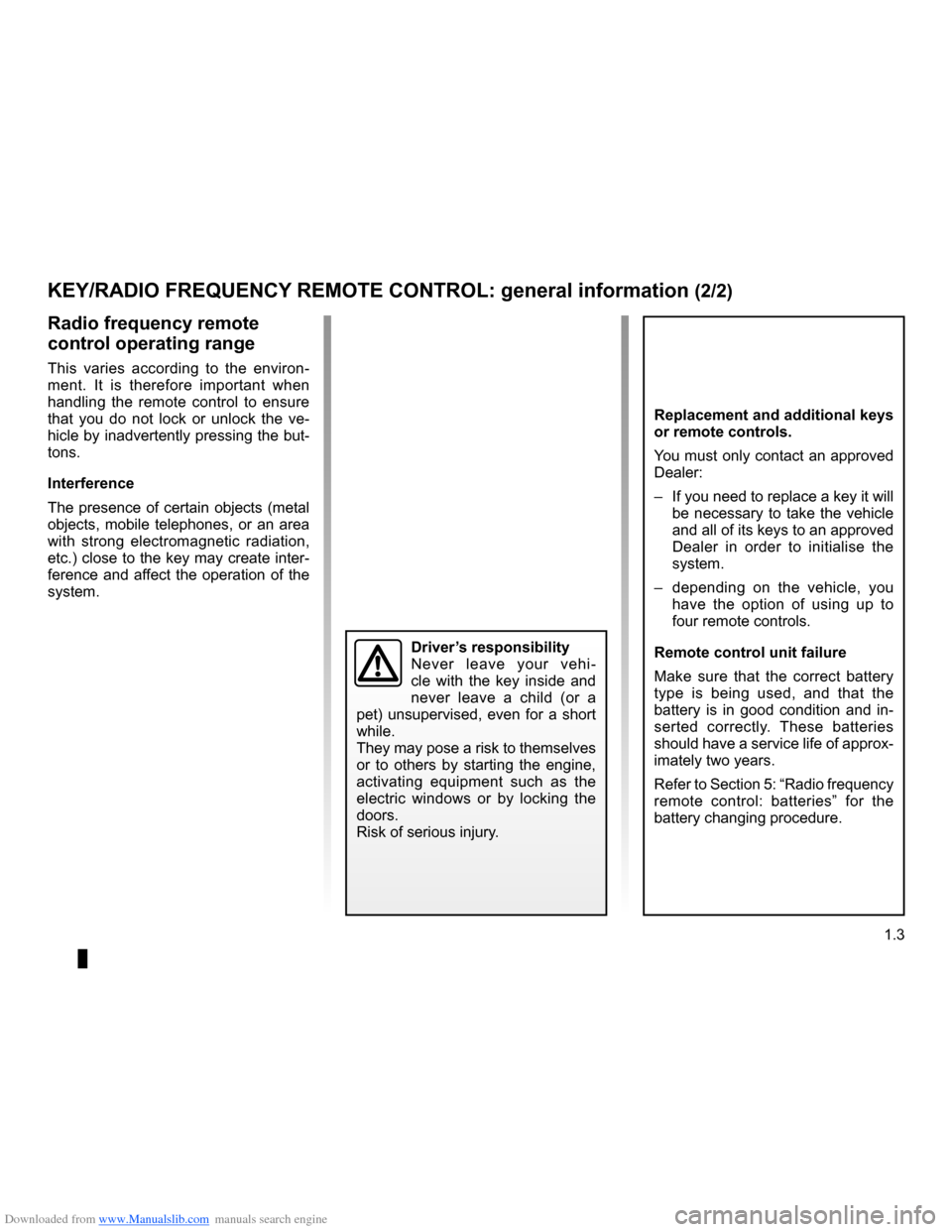
Downloaded from www.Manualslib.com manuals search engine
JauneNoirNoir texte
1.3
ENG_UD14657_2Clé / télécommande à radiofréquence : généralité\
s (X85 - B85 - C85 - S85 - K85 - Renault)ENG_NU_853-3_BCSK85_Renault_1
KEY/RADIO FREQUENCY REMOTE CONTROL: general information (2/2)
Driver’s responsibilityNever leave your vehi- cle with the key inside and never leave a child (or a pet) unsupervised, even for a short while.They may pose a risk to themselves or to others by starting the engine, activating equipment such as the electric windows or by locking the doors.Risk of serious injury.
Radio frequency remote
control operating range
This varies according to the environ- ment. It is therefore important when handling the remote control to ensure that you do not lock or unlock the ve- hicle by inadvertently pressing the but- tons.
Interference
The presence of certain objects (metal objects, mobile telephones, or an area
with strong electromagnetic radiation, etc.) close to the key may create inter- ference and affect the operation of the system.
Replacement and additional keys or remote controls.
You must only contact an approved Dealer:
– If you need to replace a key it will
be necessary to take the vehicle and all of its keys to an approved Dealer in order to initialise the system.
– depending on the vehicle, you
have the option of using up to four remote controls.
Remote control unit failure
Make sure that the correct battery type is being used, and that the battery is in good condition and in- serted correctly. These batteries should have a service life of approx- imately two years.
Refer to Section 5: “Radio frequency remote control: batteries” for the battery changing procedure.
Page 12 of 264
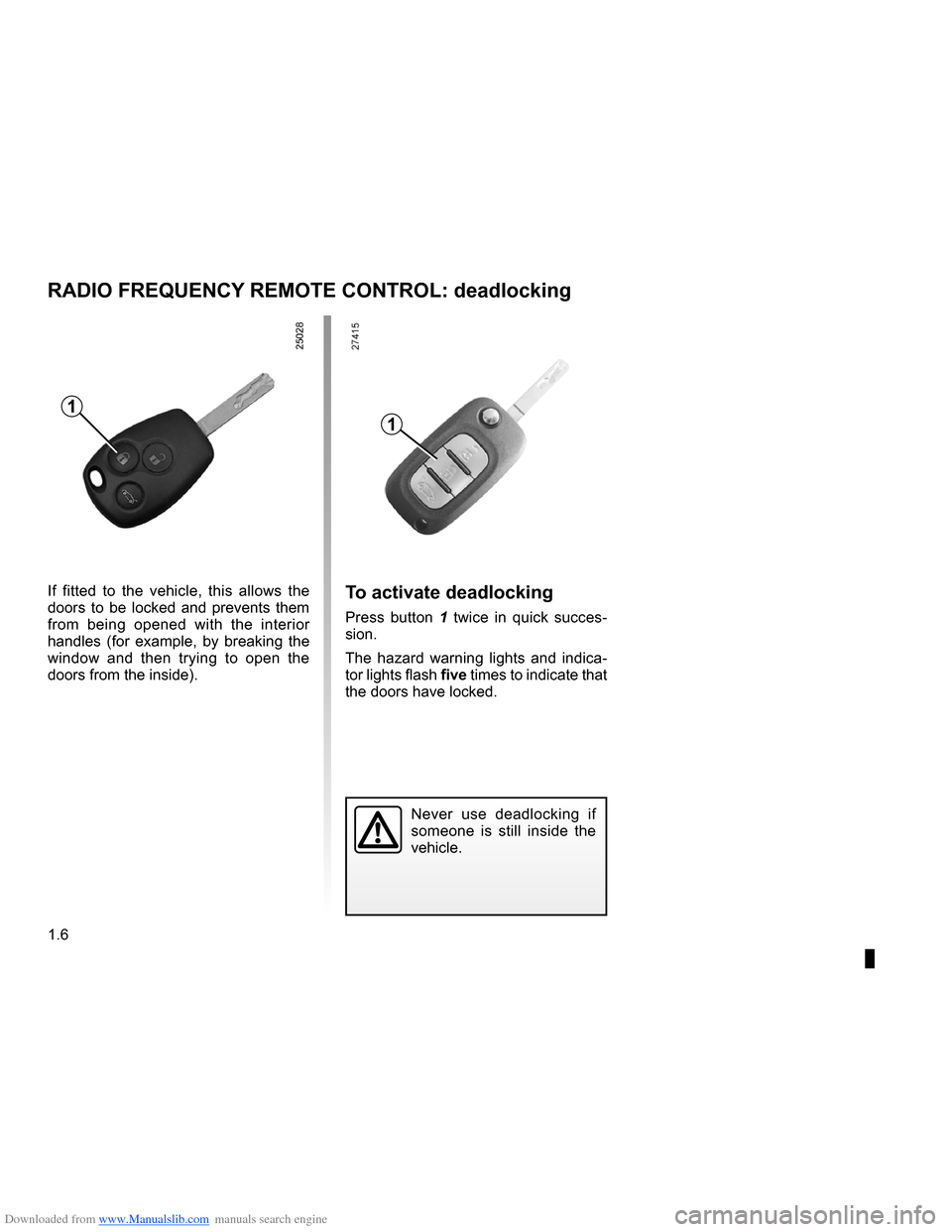
Downloaded from www.Manualslib.com manuals search engine
central door locking ..............................(up to the end of the DU)doors/tailgate ........................................(up to the end of the DU)locking the doors ..................................(up to the end of the DU)deadlocking the doors ..........................(up to the end of the DU)
1.6
ENG_UD10510_1Clé / télécommande à radiofréquence : super condamnation \
(X85 - B85 - C85 - S85 - K85 - Renault)ENG_NU_853-3_BCSK85_Renault_1
To activate deadlocking
Press button 1 twice in quick succes- sion.
The hazard warning lights and indica- tor lights flash five times to indicate that the doors have locked.
Never use deadlocking if someone is still inside the vehicle.
If fitted to the vehicle, this allows the doors to be locked and prevents them from being opened with the interior handles (for example, by breaking the window and then trying to open the doors from the inside).
RADIO FREQUENCY REMOTE CONTROL: deadlocking
1
1
Page 13 of 264
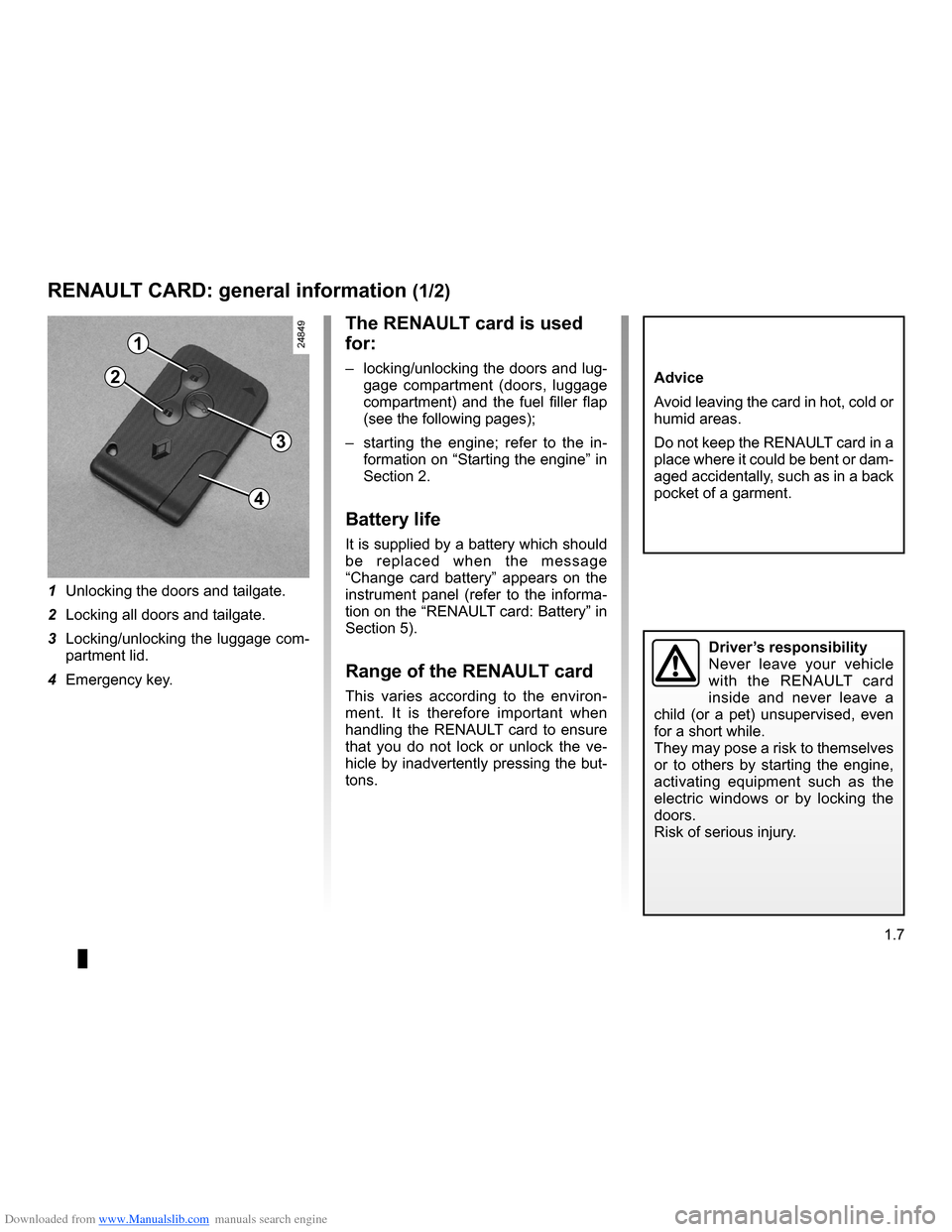
Downloaded from www.Manualslib.com manuals search engine
RENAULT carduse ..................................................(up to the end of the DU)doors/tailgate ........................................(up to the end of the DU)locking the doors ..................................(up to the end of the DU)children ..................................................................(current page)
1.7
ENG_UD10511_1Cartes Renault : généralités (X85 - B85 - C85 - S85 - K85 - Re\
nault)ENG_NU_853-3_BCSK85_Renault_1
RENAULT card: general information, use, deadlocking
The RENAULT card is used
for:
– locking/unlocking the doors and lug- gage compartment (doors, luggage compartment) and the fuel filler flap (see the following pages);
– starting the engine; refer to the in
- formation on “Starting the engine” in Section 2.
Battery life
It is supplied by a battery which should be replaced when the message “Change card battery” appears on the instrument panel (refer to the informa- tion on the “RENAULT card: Battery” in Section 5).
Range of the RENAULT card
This varies according to the environ- ment. It is therefore important when handling the RENAULT card to ensure that you do not lock or unlock the ve- hicle by inadvertently pressing the but- tons.
1 Unlocking the doors and tailgate.
2 Locking all doors and tailgate.
3 Locking/unlocking the luggage com- partment lid.
4 Emergency key.
RENAULT CARD: general information (1/2)
2
1
3
4
Driver’s responsibilityNever leave your vehicle with the RENAULT card inside and never leave a child (or a pet) unsupervised, even for a short while.They may pose a risk to themselves or to others by starting the engine, activating equipment such as the electric windows or by locking the doors.Risk of serious injury.
Advice
Avoid leaving the card in hot, cold or humid areas.
Do not keep the RENAULT card in a place where it could be bent or dam- aged accidentally, such as in a back pocket of a garment.
Page 17 of 264
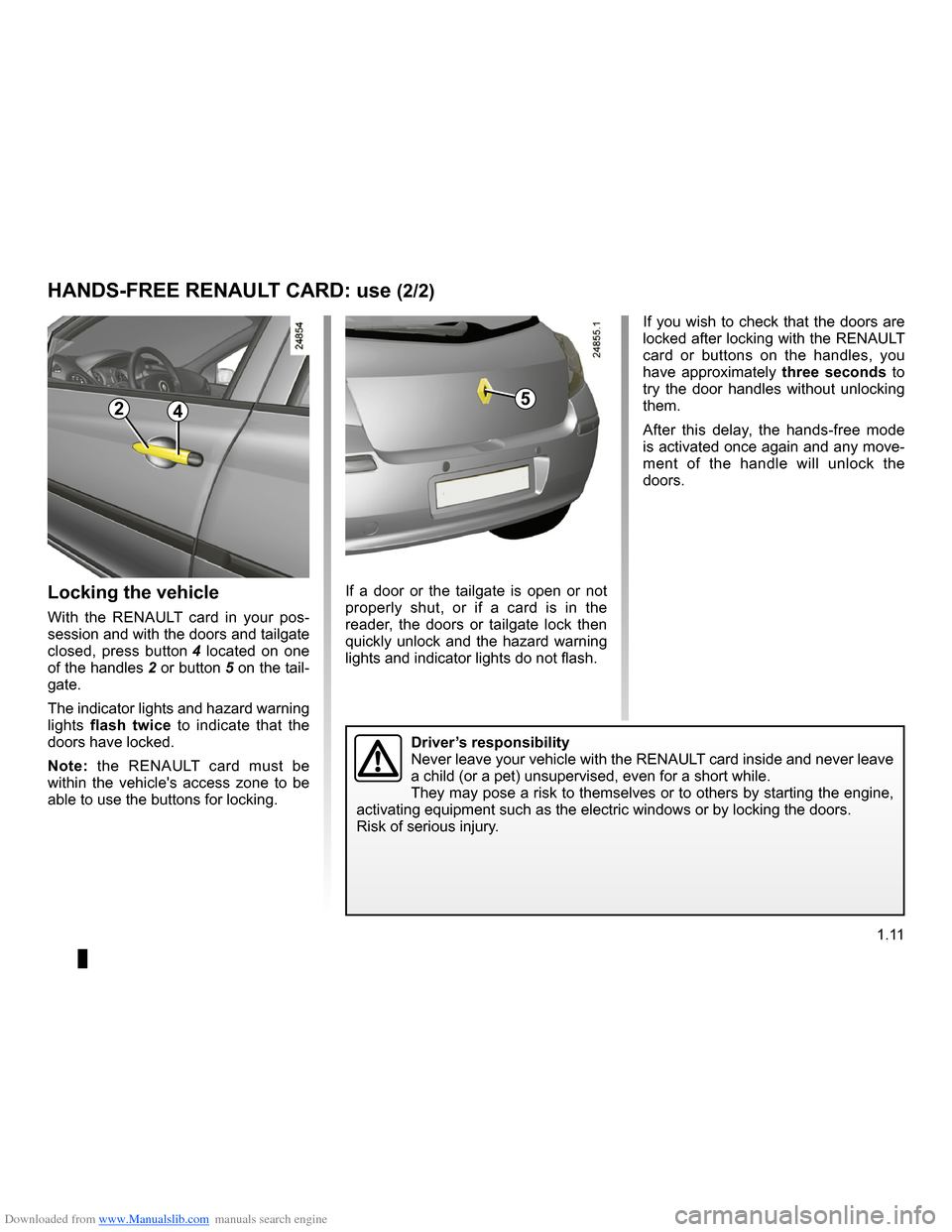
Downloaded from www.Manualslib.com manuals search engine
child safety.............................................................(current page)children ..................................................................(current page)
JauneNoirNoir texte
1.11
ENG_UD12573_2Carte Renault en mode mains libres : utilisation (X85 - B85 - C85 - S85\
- K85 - Renault)ENG_NU_853-3_BCSK85_Renault_1
If you wish to check that the doors are locked after locking with the RENAULT card or buttons on the handles, you have approximately three seconds to try the door handles without unlocking them.
After this delay, the hands-free mode is activated once again and any move- ment of the handle will unlock the doors.
If a door or the tailgate is open or not properly shut, or if a card is in the reader, the doors or tailgate lock then quickly unlock and the hazard warning lights and indicator lights do not flash.
Locking the vehicle
With the RENAULT card in your pos- session and with the doors and tailgate
closed, press button 4 located on one
of the handles 2 or button 5 on the tail- gate.
The indicator lights and hazard warning lights flash twice to indicate that the doors have locked.
Note: the RENAULT card must be within the vehicle's access zone to be able to use the buttons for locking.
HANDS-FREE RENAULT CARD: use (2/2)
245
Driver’s responsibility
Never leave your vehicle with the RENAULT card inside and never leave a child (or a pet) unsupervised, even for a short while.They may pose a risk to themselves or to others by starting the engine, activating equipment such as the electric windows or by locking the door\
s.Risk of serious injury.
Page 18 of 264
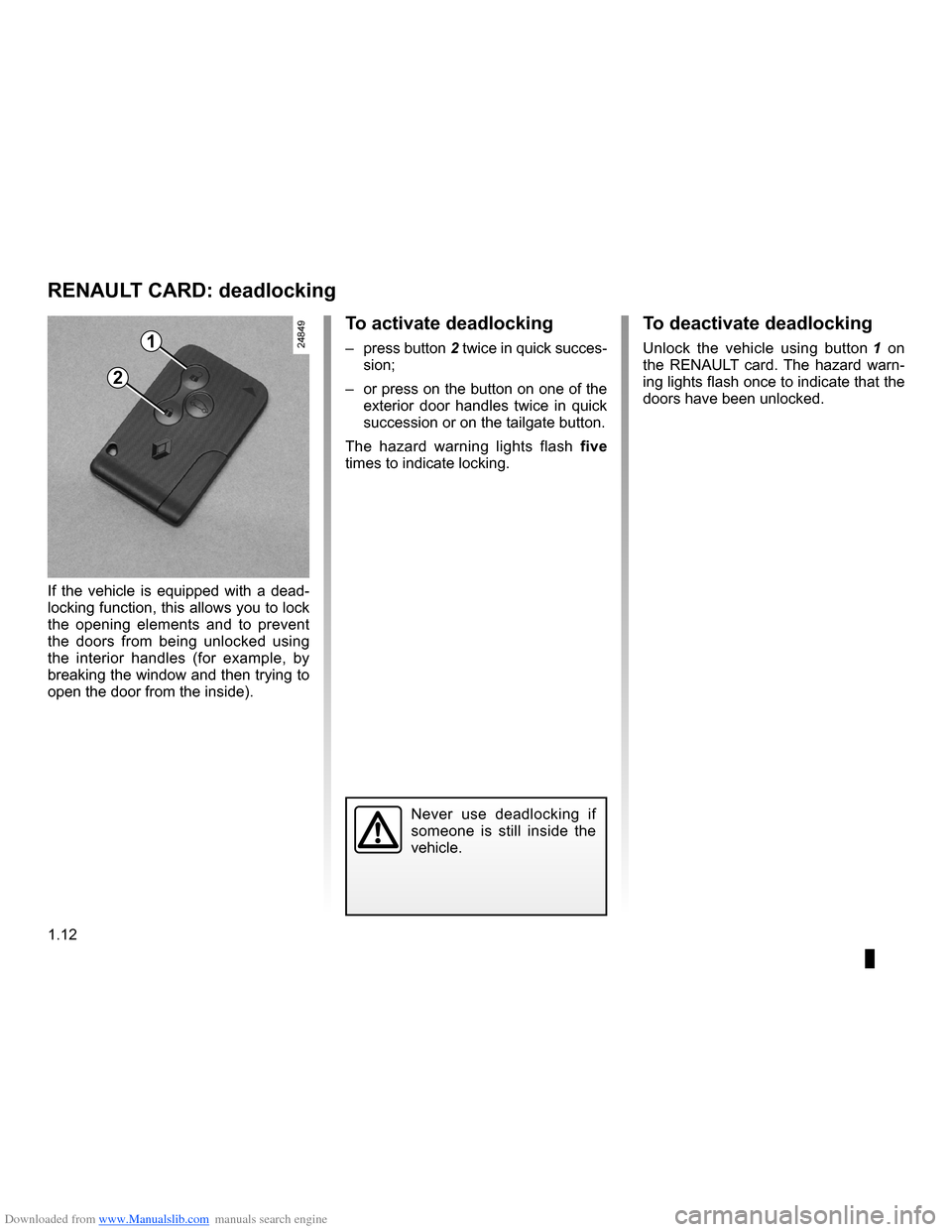
Downloaded from www.Manualslib.com manuals search engine
RENAULT carduse ..................................................(up to the end of the DU)central door locking ..............................(up to the end of the DU)doors/tailgate ........................................(up to the end of the DU)locking the doors ..................................(up to the end of the DU)deadlocking the doors ..........................(up to the end of the DU)
1.12
ENG_UD10514_1Carte Renault : super condamnation (X85 - B85 - C85 - S85 - K85 - Renau\
lt)ENG_NU_853-3_BCSK85_Renault_1
Never use deadlocking if someone is still inside the vehicle.
To activate deadlocking
– press button 2 twice in quick succes- sion;
– or press on the button on one of the
exterior door handles twice in quick succession or on the tailgate button.
The hazard warning lights flash five times to indicate locking.
If the vehicle is equipped with a dead- locking function, this allows you to lock the opening elements and to prevent the doors from being unlocked using the interior handles (for example, by breaking the window and then trying to open the door from the inside).
RENAULT CARD: deadlocking
2
To deactivate deadlocking
Unlock the vehicle using button 1 on the RENAULT card. The hazard warn- ing lights flash once to indicate that the doors have been unlocked.
1
Page 20 of 264
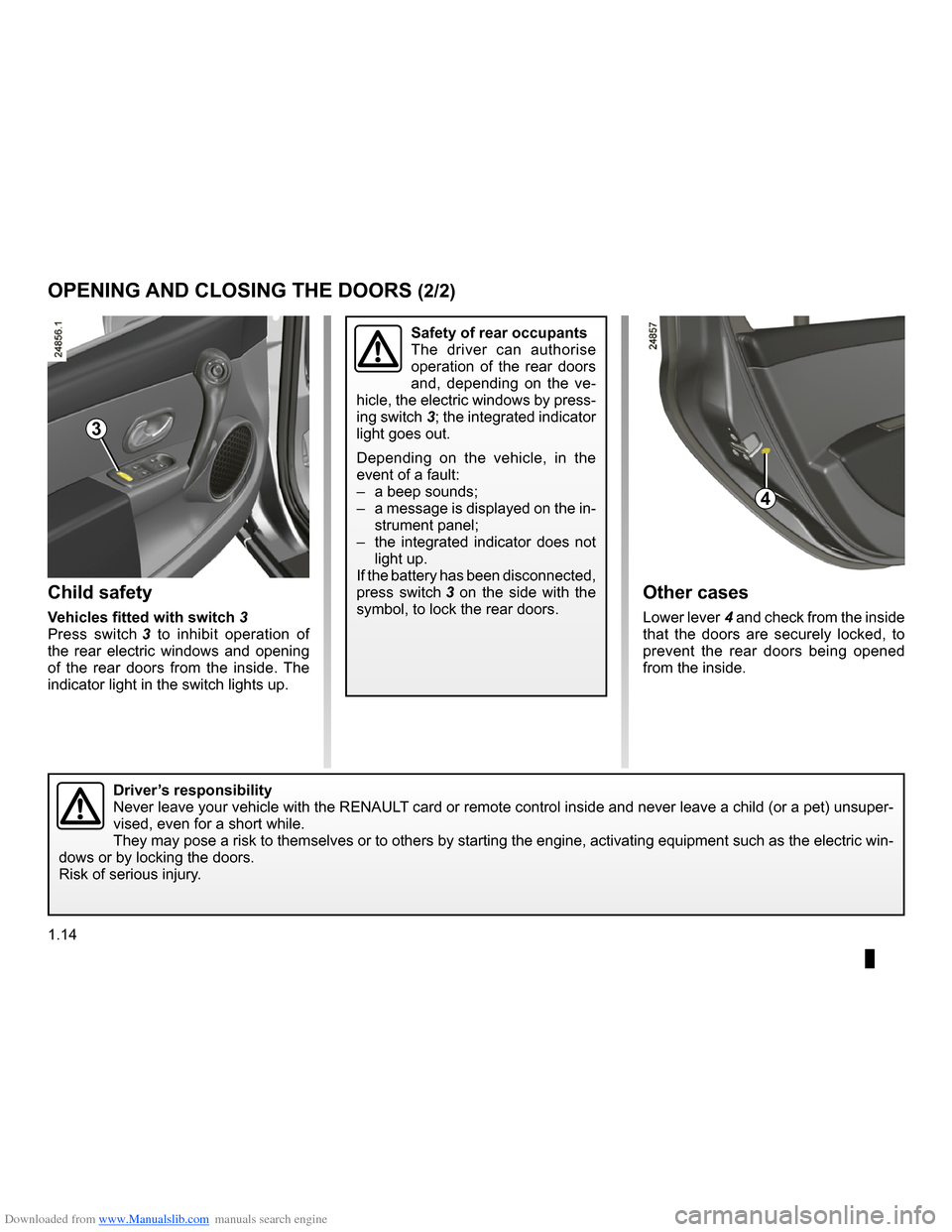
Downloaded from www.Manualslib.com manuals search engine
1.14
ENG_UD10515_1Ouverture et fermeture des portes (X85 - B85 - C85 - S85 - K85 - Renaul\
t)ENG_NU_853-3_BCSK85_Renault_1
Child safety
Vehicles fitted with switch 3
Press switch 3 to inhibit operation of the rear electric windows and opening of the rear doors from the inside. The indicator light in the switch lights up.
Other cases
Lower lever 4 and check from the inside that the doors are securely locked, to prevent the rear doors being opened from the inside.
OPENING AND CLOSING THE DOORS (2/2)
3
4
Driver’s responsibilityNever leave your vehicle with the RENAULT card or remote control inside and never leave a child (or a pet) unsuper- vised, even for a short while.They may pose a risk to themselves or to others by starting the engine, activating equipment such as the electric win- dows or by locking the doors.Risk of serious injury.
Safety of rear occupantsThe driver can authorise operation of the rear doors and, depending on the ve- hicle, the electric windows by press-
ing switch 3; the integrated indicator light goes out.
Depending on the vehicle, in the event of a fault:
– a beep sounds;
– a message is displayed on the in
- strument panel;
– the integrated indicator does not light up.If the battery has been disconnected,
press switch 3 on the side with the symbol, to lock the rear doors.
Page 41 of 264
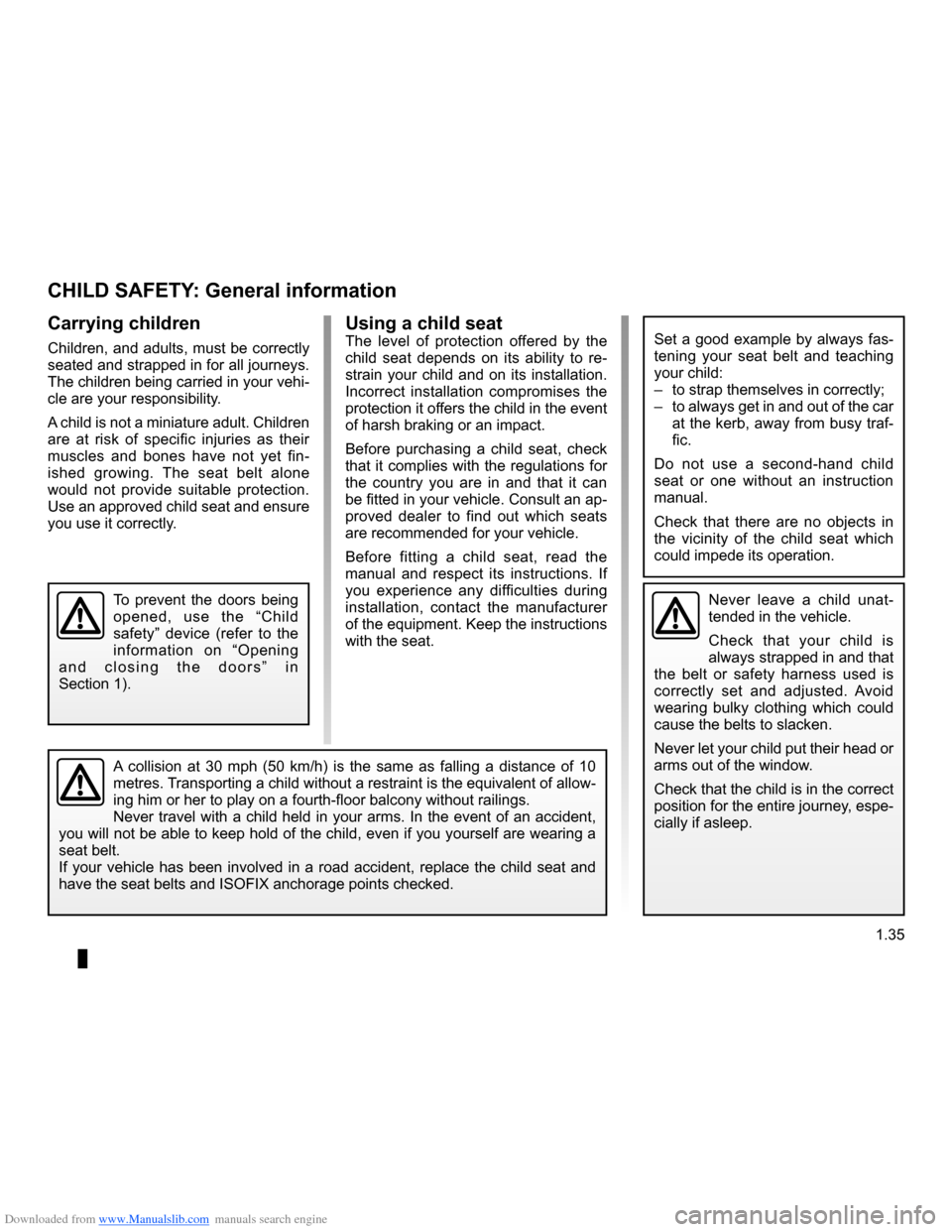
Downloaded from www.Manualslib.com manuals search engine
child safety............................................(up to the end of the DU)child restraint/seat ................................(up to the end of the DU)child restraint/seat ................................(up to the end of the DU)child restraint/seat ................................(up to the end of the DU)child seats.............................................(up to the end of the DU)transporting children .............................(up to the end of the DU)
1.35
ENG_UD10527_1Sécurité enfants : généralités (X85 - B85 - C85 - S85 - \
K85 - Renault)ENG_NU_853-3_BCSK85_Renault_1
Child safety: General information
Carrying children
Children, and adults, must be correctly seated and strapped in for all journeys. The children being carried in your vehi- cle are your responsibility.
A child is not a miniature adult. Children are at risk of specific injuries as their muscles and bones have not yet fin- ished growing. The seat belt alone would not provide suitable protection. Use an approved child seat and ensure you use it correctly.
CHILD SAFETY : General information
To prevent the doors being opened, use the “Child safety” device (refer to the information on “Opening a n d c l o s i n g t h e d o o r s ” i n
Section 1).
A collision at 30 mph (50 km/h) is the same as falling a distance of 10 metres. Transporting a child without a restraint is the equivalent of allow- ing him or her to play on a fourth-floor balcony without railings.Never travel with a child held in your arms. In the event of an accident, you will not be able to keep hold of the child, even if you yourself are wearing a seat belt.
If your vehicle has been involved in a road accident, replace the child seat and have the seat belts and ISOFIX anchorage points checked.
Using a child seatThe level of protection offered by the child seat depends on its ability to re- strain your child and on its installation. Incorrect installation compromises the protection it offers the child in the event of harsh braking or an impact.
Before purchasing a child seat, check that it complies with the regulations for the country you are in and that it can be fitted in your vehicle. Consult an ap- proved dealer to find out which seats are recommended for your vehicle.
Before fitting a child seat, read the manual and respect its instructions. If you experience any difficulties during installation, contact the manufacturer of the equipment. Keep the instructions with the seat.
Set a good example by always fas- tening your seat belt and teaching your child:
– to strap themselves in correctly;
– to always get in and out of the car
at the kerb, away from busy traf- fic.
Do not use a second-hand child seat or one without an instruction manual.
Check that there are no objects in the vicinity of the child seat which could impede its operation.
Never leave a child unat- tended in the vehicle.
Check that your child is always strapped in and that the belt or safety harness used is correctly set and adjusted. Avoid wearing bulky clothing which could cause the belts to slacken.
Never let your child put their head or arms out of the window.
Check that the child is in the correct position for the entire journey, espe- cially if asleep.
Page 43 of 264
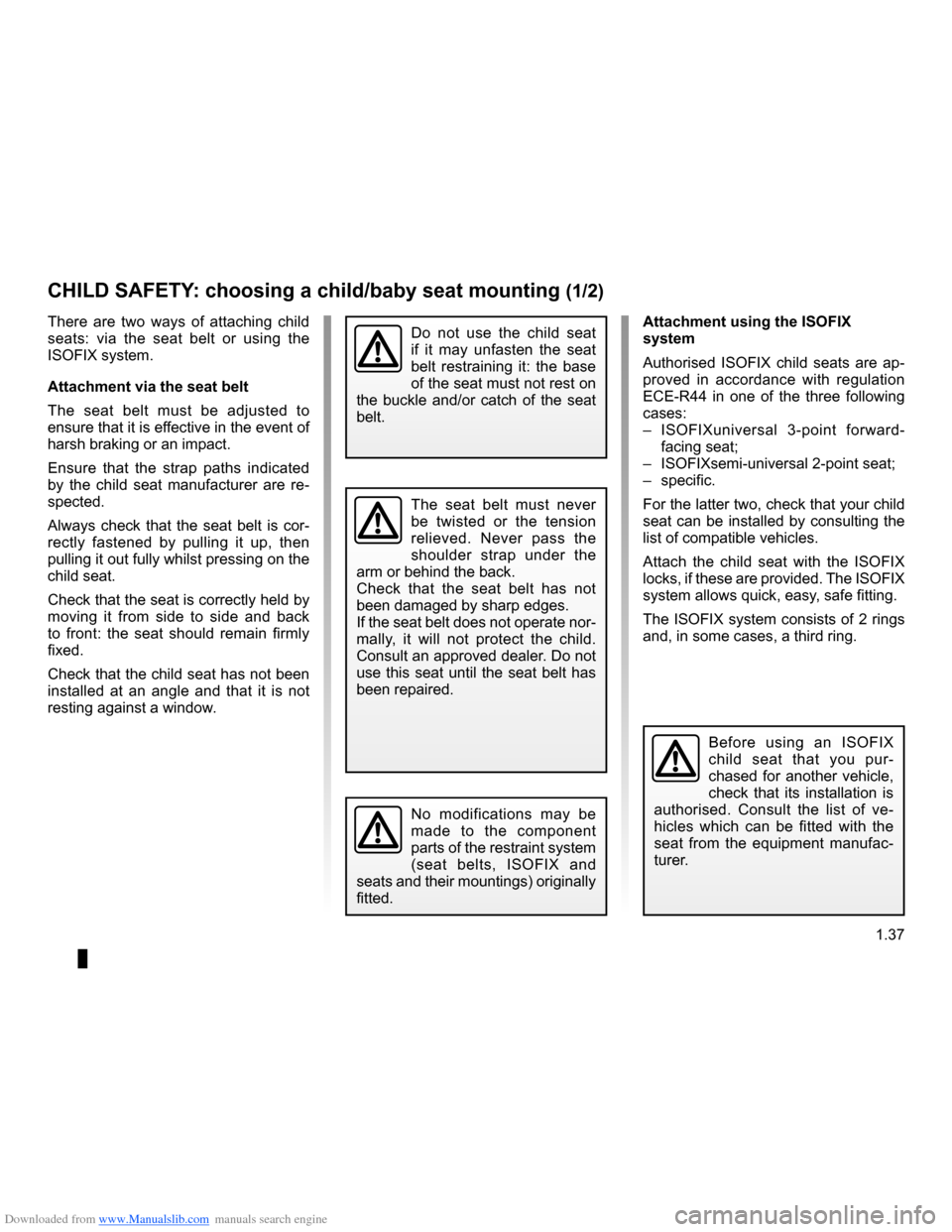
Downloaded from www.Manualslib.com manuals search engine
child restraint/seat ................................(up to the end of the DU)child restraint/seat ................................(up to the end of the DU)child restraint/seat ................................(up to the end of the DU)child safety............................................(up to the end of the DU)child seats.............................................(up to the end of the DU)transporting children .............................(up to the end of the DU)Isofix .....................................................(up to the end of the DU)
1.37
ENG_UD10528_1Sécurité enfants : choix de la fixation du siège enfant (X85 -\
B85 - C85 - S85 - K85 - Renault)ENG_NU_853-3_BCSK85_Renault_1
Choosing a child seat mounting
CHILD SAFETY : choosing a child/baby seat mounting (1/2)
There are two ways of attaching child seats: via the seat belt or using the ISOFIX system.
Attachment via the seat belt
The seat belt must be adjusted to ensure that it is effective in the event of harsh braking or an impact.
Ensure that the strap paths indicated by the child seat manufacturer are re- spected.
Always check that the seat belt is cor- rectly fastened by pulling it up, then pulling it out fully whilst pressing on the child seat.
Check that the seat is correctly held by moving it from side to side and back to front: the seat should remain firmly fixed.
Check that the child seat has not been installed at an angle and that it is not resting against a window.
Do not use the child seat if it may unfasten the seat belt restraining it: the base of the seat must not rest on the buckle and/or catch of the seat belt.
The seat belt must never be twisted or the tension relieved. Never pass the shoulder strap under the arm or behind the back.Check that the seat belt has not been damaged by sharp edges.If the seat belt does not operate nor- mally, it will not protect the child. Consult an approved dealer. Do not use this seat until the seat belt has been repaired.
No modifications may be made to the component parts of the restraint system (seat belts, ISOFIX and seats and their mountings) originally fitted.
Attachment using the ISOFIX system
Authorised ISOFIX child seats are ap- proved in accordance with regulation ECE-R44 in one of the three following cases:
– ISOFIXuniversal 3-point forward- facing seat;
– ISOFIXsemi-universal 2-point seat;
– specific.
For the latter two, check that your child seat can be installed by consulting the list of compatible vehicles.
Attach the child seat with the ISOFIX locks, if these are provided. The ISOFIX system allows quick, easy, safe fitting.
The ISOFIX system consists of 2 rings and, in some cases, a third ring.
Before using an ISOFIX
child seat that you pur- chased for another vehicle, check that its installation is authorised. Consult the list of ve- hicles which can be fitted with the seat from the equipment manufac- turer.
Page 96 of 264
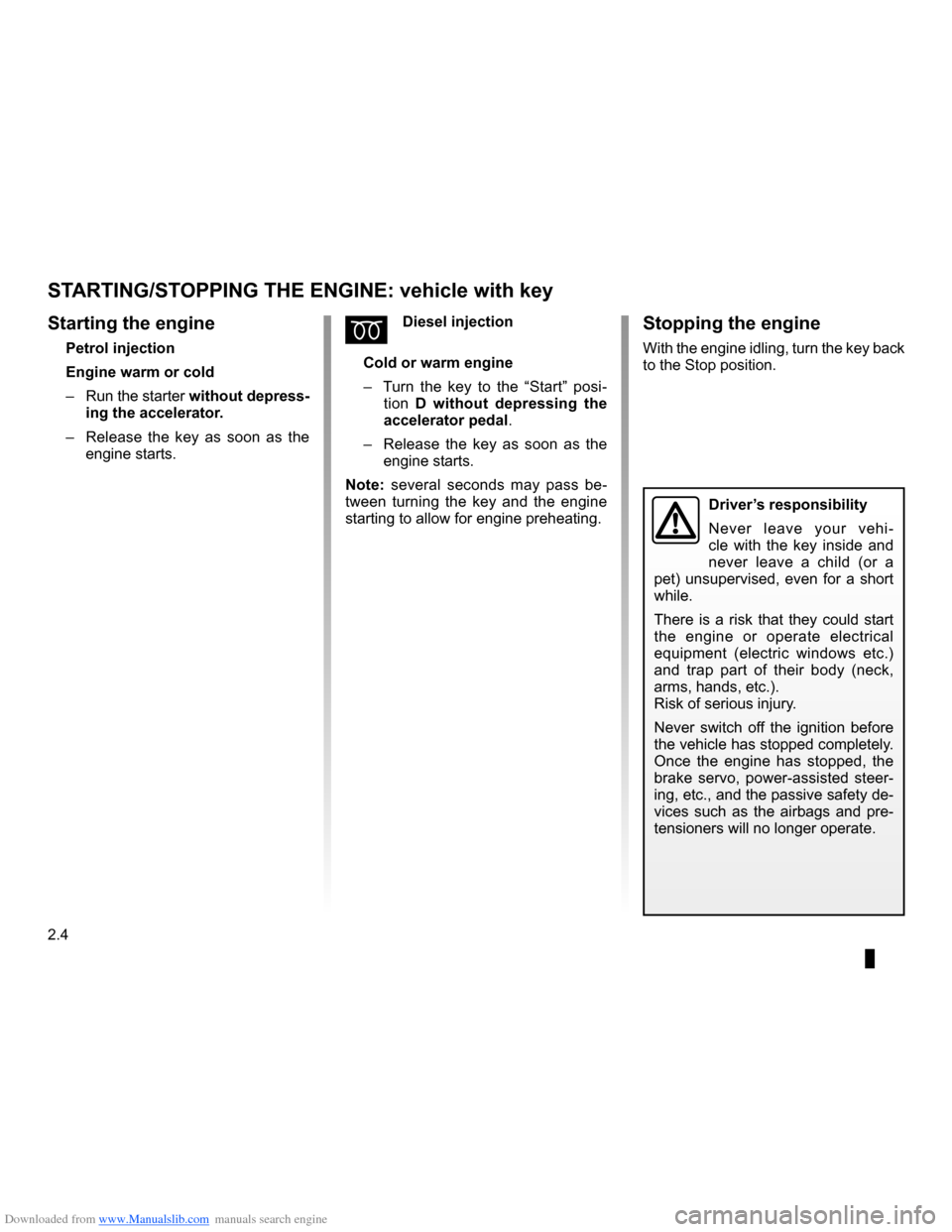
Downloaded from www.Manualslib.com manuals search engine
stopping the engine ..............................(up to the end of the DU)engine start/stop button ........................(up to the end of the DU)driving ...................................................(up to the end of the DU)starting the engine ................................(up to the end of the DU)
2.4
ENG_UD10550_1Démarrage / arrêt moteur : véhicule avec clé / télécom\
mande à radiofréquence (X85 - B85 - C85 - S85 - K85 - Renault)ENG_NU_853-3_BCSK85_Renault_2
Starting/stopping the engine using the key
Stopping the engine
With the engine idling, turn the key back to the Stop position.
ÉDiesel injection
Cold or warm engine
– Turn the key to the “Start” posi
- tion D without depressing the accelerator pedal.
– Release the key as soon as the
engine starts.
Note: several seconds may pass be- tween turning the key and the engine starting to allow for engine preheating.
Starting the engine
Petrol injection
Engine warm or cold
– Run the starter
without depress- ing the accelerator.
– Release the key as soon as the
engine starts.
STARTING/STOPPING THE ENGINE: vehicle with key
Driver’s responsibility
Never leave your vehi- cle with the key inside and never leave a child (or a pet) unsupervised, even for a short while.
There is a risk that they could start the engine or operate electrical equipment (electric windows etc.) and trap part of their body (neck, arms, hands, etc.).Risk of serious injury.
Never switch off the ignition before the vehicle has stopped completely. Once the engine has stopped, the brake servo, power-assisted steer- ing, etc., and the passive safety de- vices such as the airbags and pre- tensioners will no longer operate.
Page 97 of 264
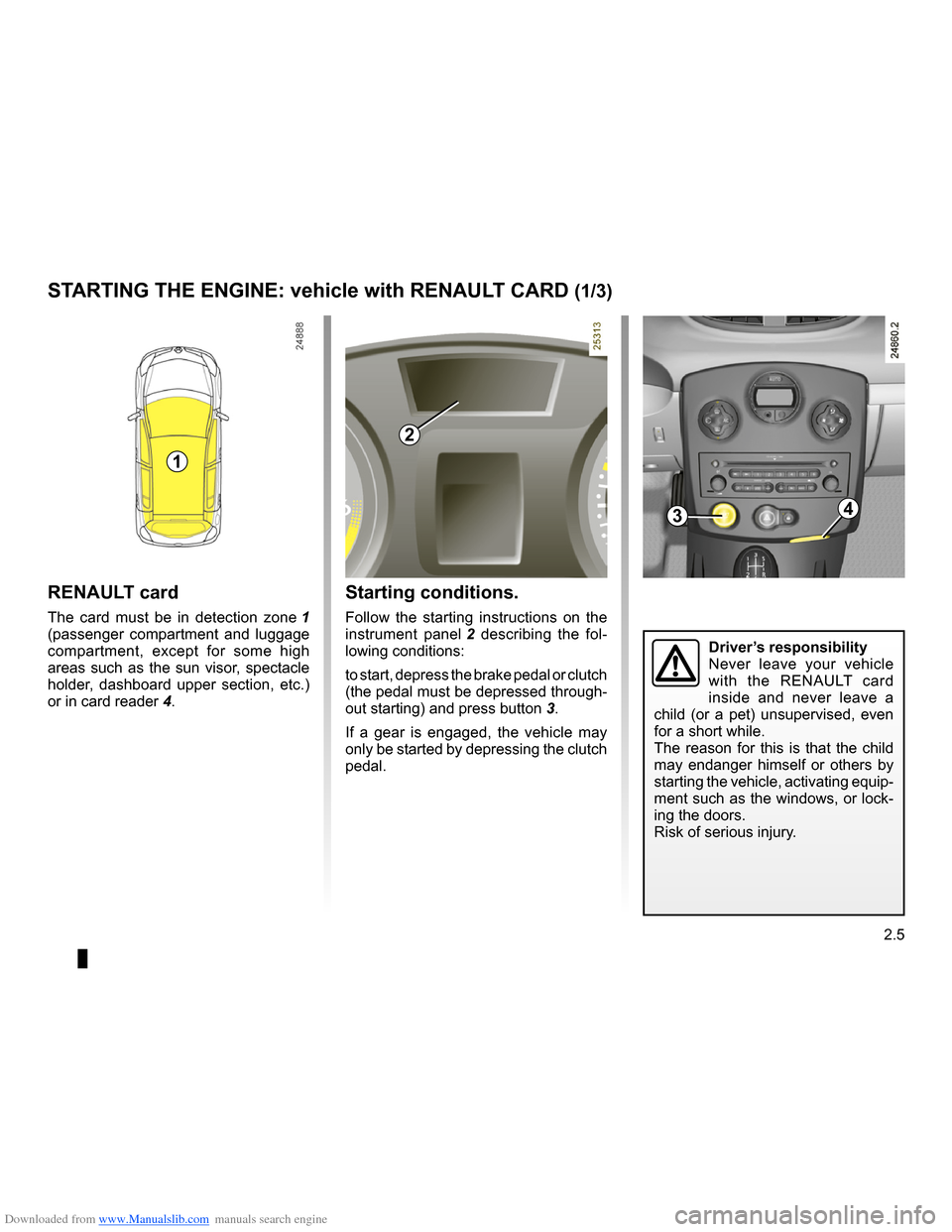
Downloaded from www.Manualslib.com manuals search engine
stopping the engine ..............................(up to the end of the DU)engine start/stop button ........................(up to the end of the DU)RENAULT carduse ..................................................(up to the end of the DU)starting the engine ................................(up to the end of the DU)driving ...................................................(up to the end of the DU)child safety.............................................................(current page)
2.5
ENG_UD10551_1Démarrage moteur : véhicule avec carte Renault (X85 - B85 - C85 -\
S85 - K85 - Renault)ENG_NU_853-3_BCSK85_Renault_2
Starting - stopping the engine using the RENAULT card
Starting conditions.
Follow the starting instructions on the
instrument panel 2 describing the fol- lowing conditions:
to start, depress the brake pedal or clutch (the pedal must be depressed through-
out starting) and press button 3.
If a gear is engaged, the vehicle may only be started by depressing the clutch pedal.
RENAULT card
The card must be in detection zone 1 (passenger compartment and luggage compartment, except for some high areas such as the sun visor, spectacle holder, dashboard upper section, etc.)
or in card reader 4.
STARTING THE ENGINE: vehicle with RENAULT CARD (1/3)
1
2
34
Driver’s responsibilityNever leave your vehicle with the RENAULT card inside and never leave a child (or a pet) unsupervised, even for a short while.The reason for this is that the child may endanger himself or others by starting the vehicle, activating equip- ment such as the windows, or lock- ing the doors.Risk of serious injury.